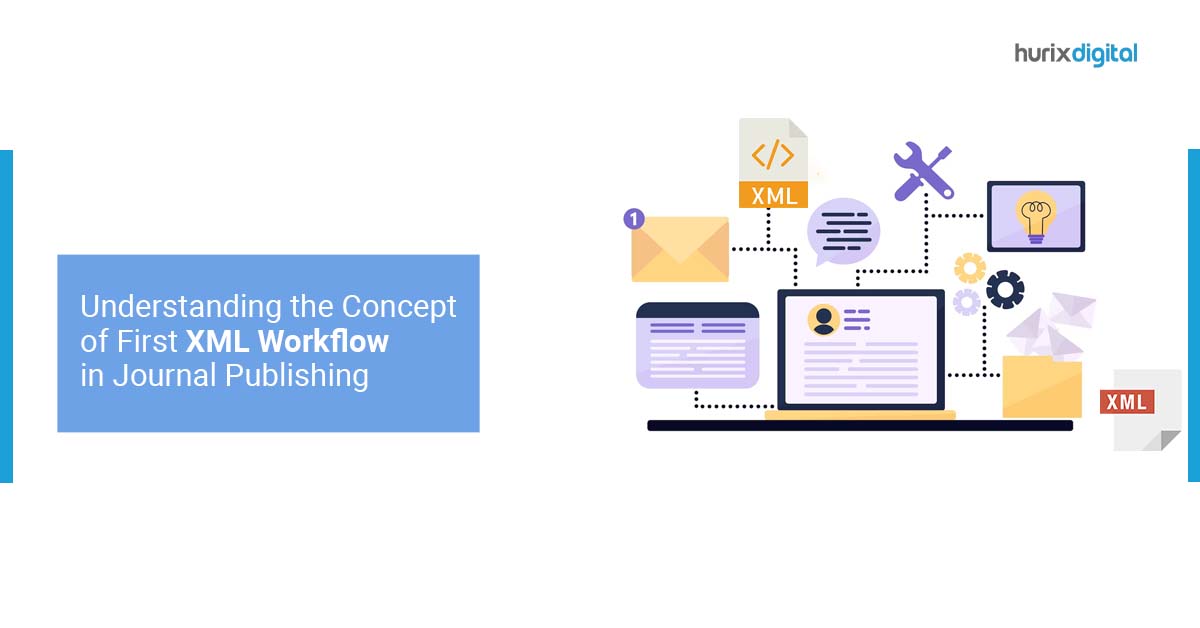
Why Do Publishers Need An XML Workflow?
Table of Contents:
- What is an XML workflow?
- Reference Tables For The Workflows XML Schema
- What are the Benefits of an XML Workflow
- Conclusion
What is an XML workflow?
Publishers generally receive manuscripts in a Word file format from the authors, subject matter experts and other contributors. They then have to typeset on publishing software such as InDesign to create interactive PDF files as end deliverables. This kind of workflow is however not dynamic in nature. A better approach is to use a markup language which is ideal as a publishing process in any digital publishing environment.
Extensible Markup Language or XML is the new standard in digital publishing. An XML workflow is extensible as it allows you to define your own tags in the order they occur and the way they should be processed or displayed. Markup means that you can define each element in the XML as a tag or a set of tags. XML is also a meta-language, similar to HTML but much more flexible.
Related Read – Role of XML Publishing Software in Print and Digital Publishing
An XML workflow removes all limitations of size and layout and can convert all types of document formats into information-ready files which can be displayed and interpreted on all device types.
The XML-first approach is common with all publishers who use it to produce any form of digital content. This new style of publishing is based on the size and layout-agnostic principle. In the traditional publishing approach, content is first created and edited, then converted into the PDF and finally, the XML tags are inserted. In the XML publishing approach, the XML tags are inserted first and the entire documents are then formulated with the XML retrospective effect. The XML then severs all ties between the content and format, making the content secure and editable and ready to consume on virtually all device types.
With XML, publishers can simplify the publishing process and deliver content in multiple formats such as PDF, HTML, ePapers, eMagazines and ePub. And since XML breaks the ties between content and format, with XML workflow, publishers can also repurpose the layouts and content across various platforms such as QuarkXPress and InDesign.
Related Read – How to Convert an XML ePUB – Step-by-Step Guide
E-Book:
Hurix Mini-Book: PrePress Tips You Won’t Find Anywhere Else
Reference Tables For The Workflows XML Schema
Below reference tables outline the various elements and attributes used in the Workflows XML schema, providing a guide for understanding and working with the schema –
Table 1: Workflow Elements
| Element | Description |
| Workflow | Represents the root element of the Workflows XML schema. |
| Name | Specifies the name of the workflow. |
| Description | Provides a description of the workflow. |
| Steps | Contains a collection of individual workflow steps. |
| Variables | Defines variables used within the workflow. |
Table 2: Step Elements
| Element | Description |
| Step | Represents an individual step within the workflow. |
| Name | Specifies the name of the step. |
| Type | Indicates the type of step, such as “Task” or “Decision”. |
| Description | Provides a description of the step. |
| Parameters | Defines the parameters required for the step. |
Table 3: Variable Elements
| Element | Description |
| Variable | Represents a variable used within the workflow. |
| Name | Specifies the name of the variable. |
| Type | Indicates the data type of the variable. |
| DefaultValue | Sets the default value for the variable. |
| Description | Provides a description of the variable. |
What are the Benefits of an XML Workflow
- Intuitive documents – With an XML workflow, you can create intuitive documents that can be adapted to any publishing medium. You can also easily repackage the content to edit and remove redundancies. An XML workflow also minimizes the need to convert content from one format to another, thereby reducing costs and efforts while increasing efficiency.
- Ease of collaboration – An XML workflow incorporates XML tags right at the first step of the authoring stage and so different editors/SMEs can collaborate together and handle independent chapters simultaneously. XML, therefore, makes it possible to effortlessly incorporate changes and design content that is ideal for the online environment and an international audience.
- Web-ready content – An XML workflow enables web-ready content. As a publisher, you stand to benefit as you can effortlessly restructure your content across different platforms and channels and amplify your messaging and marketing leadership.
- Common file formats – An XML workflow creates common information formats which you can share on the internet, intranets and other places using standard ASCII text. It also encodes the documents in a format that can be read by both humans and search engines, thereby increasing the visibility of the content.
- Greater consumer value – As said, XML-based content can be viewed across all reader devices and multiple formats. With XML workflows you can attract more readers and hold their attention. Besides, with XML, you can ensure uniformity in presentation, which will help you build your brand and at the same time, ensure greater value to your customers.
- Cross-browser capabilities – XML files are compatible with all browsers and therefore have greater cross-browser capabilities for the documents. You can increase your audience reach and improve your business prospects since more people can access your content.
- Increased productivity – With an XML workflow, you can convert all your documents into a common format. This will enable your employees to easily find any document and carry out their jobs without having to waste their time searching for data in various formats.
- Improved search engine optimization – An XML workflow allows you to arrange your data sequentially, which makes it easier for the search engine to index it and present it in a readable format. This will improve the searchability of your content, making it visible to your target audience.
- Highly flexible content – XML content is highly adaptable, scalable, and highly flexible, allowing you to repurpose it as many times as you like, in the format of your choice, and customize it to meet specific requirements. You can add XML-first as a new step in your workflow without having to overhaul your entire system.
- Economical and effective – XML is a schema-driven language that does not require any programming which means that you can economically and easily format to publish your content on the web.
Case Study – Hurix Digital Converts XML Files to HTML and Publishes 250,000 Backlist Titles
In conclusion
By adopting XML workflows, you can produce adaptable content that is easily compatible with the constantly evolving digital channels, browsers and devices. Apart from implementing XML workflows in new content, you can also choose a process for your old content which exists in other formats.
By converting your existing content to XML, you can benefit from streamlined workflows, increased productivity, reduced costs, increased efficiency and greater business prospects. With the help of reliable service providers who follow compliance standards and best practices, you can ensure a highly efficient process, high-quality output, well-structured and highly reusable content files.
An expert XML data conversion service provider will also have efficient data protection and security systems in place to prevent any data leakage, theft or unauthorized access.
In conclusion, the adoption of XML publishing workflow is crucial for publishers to thrive in today’s digital landscape. XML publishing offers the advantage of structured content creation, management, and distribution. By implementing a workflow XML, publishers can optimize their publishing workflow, ensuring efficiency, consistency, and adaptability. Embracing XML publishing enables publishers to stay ahead and effectively cater to the diverse demands of modern readership.
Need to know more about our Products & Services ? Drop us a note at marketing@hurix.com.

Vice President – Digital Content Transformation. He is PMP, CSM, and CPACC certified and has 20+ years of experience in Project Management, Delivery Management, and managing the Offshore Development Centre (ODC).





